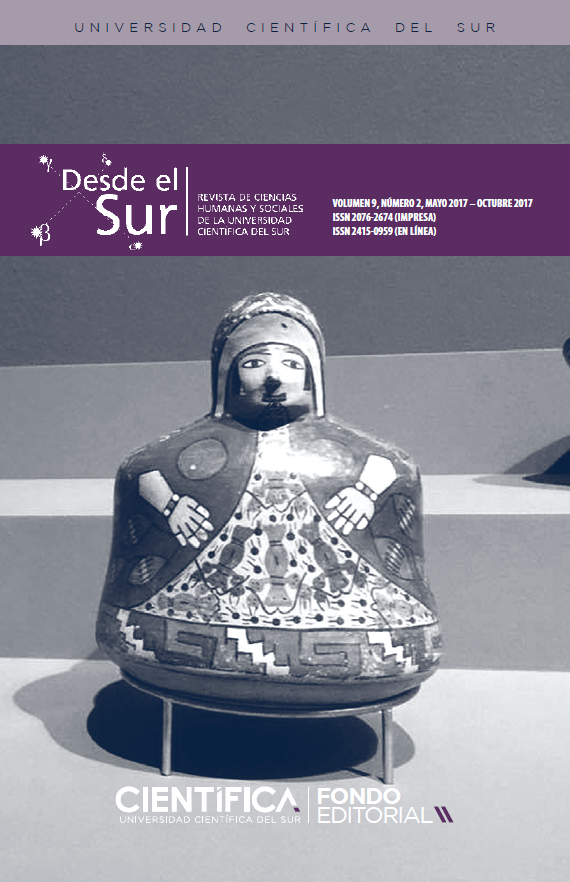Hablando con las manos, oyendo con los ojos ¿Qué puede decirnos la comunicación de primates no humanos sobre el lenguaje humano?
DOI:
https://doi.org/10.21142/DES-902-2017-381-394Palabras clave:
Comunicación, Señales funcionalmente referenciales, Primates, Lenguas de signos, Teoría de la mente, Gesto, AlarmaResumen
La complejidad del lenguaje hace que sea un campo de estudio abordado en perspectiva multidisciplinar. La
comunicación entre primates ha servido para establecer un interesante debate teórico sobre cómo emergió y evolucionó el lenguaje moderno. En la última década, los estudios en primatología y en lenguas de signos apuntaban a un origen gestual; sin embargo, nuevas perspectivas integradoras se inclinan a una coevolución de gesto y sonido. Este marco de estudio es especialmente relevante para reflexiones antropológicas que ayuden a reflexionar sobre sus implicaciones ontológicas y culturales.
Descargas
Referencias
Arbib, M. A., Liebal, K., & Pika, S. (2008): Primate vocalization, gesture and the evolution of human language. Current Anthropology, 49 (6), 1053–1076.
Call, J., & Tomasello, M. (2008): Does the chimpanzee have a theory of mind? 30 years later; Trends in cognitive sciences, 12 (5), 187–192.
Chalcraft , V. J., & Gardner, R. A. (2005): Cross-fostered chimpanzees modulate signs of American Sign Language. Gesture, 5 (1–1), 107–132.
Cochet , H., & Vauclair, J. (2010): Pointing gestures produced by toddlers from 15 to 30 months: Different functions, hand shapes and laterality patterns. Infant Behaviour and Development, 33 (4), 431–441.
Colletta , J. M., Guidetti, M., Capirci, O., Cristilli, C., Demir, O. E., Kunene-Nicolas, R. N., & Levine, S. (2015): Effects of age and language on co-speech gesture production: an investigation of French, American and Italian children's narratives. Journal of Child Language, 42 (01), 122–145.
Corballis, M. (1999): The Gestural Origins of Language: Human language may have evolved from manual gestures, which survive today as a “behavioural fossil" coupled to speech. American Scientist, 87 (2), 138–146.
_______________ (2002): From hand to mouth: The origins of language. Princeton University Press.
Dani Hernández (2011, November 22): Test de Sally-Anne. [Video file]: Retrieved from: https://www.youtube.com/watch?v=GVKSijVWRb4.
Dunbar, R. I. (2004): Gossip in evolutionary perspective; Review of general psychology, 8 (2), 100.
Emmorey , K. (2001): Language, cognition, and the brain: Insights from sign language research; Psychology Press.
Fedurek, P., & Slocombe, K. E. (2011): Primate vocal communication: a useful tool for understanding human speech and language evolution? Human Biology, 83 (2), 153–173.
Fouts , R. S., Fouts, D. H., & Van Cantfort, T. E. (1989): The infant Loulis learns signs from cross-fostered chimpanzees. Teaching sign language to chimpanzees, 280–292.
Freeberg , T.M., Dunbar, R. I. M., & Ord, T. J. (2012): Social complexity as a proximate and ultimate factor in communicative complexity. Philosophical Transactions of the Royal Society B, 367, 1785–1801.
Gardner, R. A., & Gardner, B. T. (1969): Teaching sign language to a chimpanzee. Science, 165 (3894), 664–672.
Ghazanfar , A. A., & Eliades, S. J. (2014): The neurobiology of primate vocal communication. Current opinion in neurobiology, 28, 128–135.
Grünloh , T., & Liszkowski, U. (2015): Prelinguistic vocalizations distinguish pointing acts. Journal of child language: Volume 42 (06), 1312–1336.
Hauser , M. D., Chomsky, N., & Fitch, W. T. (2002): The faculty of language: What is it, who has it, and how did it evolve? Science, 298 (5598), 1569– 1579.
Hayes , K. J., & Hayes, C. (1951): The intellectual development of a homeraised chimpanzee. Proceedings of the American Philosophical Society, 95 (2), 105-109.
Hobaiter, C., & Byrne, R. W. (2014): The meanings of chimpanzee gestures. Current Biology, 24 (14), 1596–1600
Kendon, A. (2013) History of the study of gesture. In K. Allan (ed.): The Oxford Handbook of the History of Linguistics, OUP, Oxford.
_______________ (2016): Reflections on the “gesture-first” hypothesis of language origins. Psychonomic Bulletin & Review, 1–8.
Lemasson , A. (2011): What can forest guenons «tell» us about the origin of language? In A. Vilain, J.- L. Schwartz, C. Abry, and J. Vauclair (eds.), Primate communication and human language. Amsterdam: John Benjamins Publishing Company, pp. 39–70.
Liebal, K., Waller, B. M., Slocombe, K. E., & Burrows, A. M. (2013): Primate Communication: A multimodal approach, Cambridge University Press.
Maestripieri, D. (2005): Gestural communication in three species of macaques (Macaca mulatta, M. nemestrina, M. arctoides): Use of signals in relation
to dominance and social context. Gesture, 5 (1-2), 57–73.
Marentette , P., Pettenati, P., Bello, A., & Volterra, V. (2016): Gesture and Symbolic Representation in Italian and English‐Speaking Canadian 2‐Year‐Olds: Child development, 87 (3), 944–961.
Meguerditchian , A., Cochet, H., & Vauclair, J. (2011): From gesture to language: Ontogenetic and phylogenetic perspectives on gestural communication and its cerebral lateralization. In A. Vilain, J.L. Schwartz, C. Abry, & J. Vauclair (eds.): Primate Communication and Human Language. Amsterdam,
Netherlands: Jonh Benjamins Publishing Compaby, pp, 91–119.
NFLD Archive (a) (2015, October 24) First signs of Washoe, Part 1 of 2 [Video file], retrieved from:
https://www.youtube.com/watch?v=fxCOphC7kXw&t=915s
NFLD Archive (b) (2015, October 24) First signs of Washoe, Part 2 of 2. [video file]. Retrieved from:
https://www.youtube.com/watch?v=fxCOphC7kXw&t=915s
Patterson , F. G. (1978): The gestures of a gorilla: Language acquisition in another Pongid; Brain and Language, 5 (1), 72–9
Patterson , F. G., & Cohn, R. H. (1990): Language acquisition by a lowland gorilla: Koko's first ten years of vocabulary development. Word, 41(2), 97–143
Penn, D. C., & Povinelli, D. J. (2007): On the lack of evidence that nonhuman animals possess anything remotely resembling a ‘theory of mind’. Philosophical Transactions of the Royal Society of London B: Biological Sciences, 362 (1480), 731–744
Pfefferle, D., Brauch, K., Heistermann, M., Hodges, J. K., & Fischer, J.(2008): Female Barbary macaque (Macaca sylvanus) copulation calls do not reveal the fertile phase but influence mating outcome. Proceedings of the Royal Society of London B: Biological Sciences, 275 (1634), 571–578.
Pika , S., Liebal, K., & Tomasello, M. (2005): Gestural communication in sub adult bonobos (Pan paniscus): Repertoire and use; American Journal of Primatology, 65 (1), 39–61
Pika , S., & Mitani, J. (2006): Referential gestural communication in wild chimpanzees (Pan troglodytes); Current Biology, 16 (6), R191–R192.
Pika , S., Liebal, K., Call, J., & Tomasello (2007): The gestural communication of apes; In Liebal, K., Muller., C, & Pika, S. (ed.):The gestural communication of apes and monkeys, Taylor & Francis Group/Lawrence Erlbaum Associates.
Richard Dawkins Foundation for Reason & Science (2010, May 19): Robert Seyfarth: Theory of Mind. [video file]. Retrieved from: https://www.youtube.com/watch?v=XDtjLSa50uk
Savage -Rumbaugh , S., Fields, W. M., & Spircu, T. (2004): The emergence of knapping and vocal expression embedded in a Pan/Homo culture; Biology and Philosophy, 19 (4), 541–575.
Senghas, A., & Coppola, M. (2001): Children creating language: How Nicaraguan Sign Language acquired a spatial grammar; Psychological Science, 12 (4), 323–328.
Senghas, A., Kita, S., & Özyürek, A. (2004): Children creating core properties of language: Evidence from an emerging sign language in Nicaragua. Science, 305 (5691), 1779–1782
Slocombe , K. E., Waller, B. M., & Liebal, K. (2011): The Language Void: The need for multimodality in primate communication research; Animal Behaviour, 81 (5), 919–924.
Seyfarth , R. M & Cheney, D. L. (2003): The structure of social knowledge in monkeys. In: Animal social complexity: Intelligence, culture and individualized societies, F. B. M. de Waal and P. L. Tyack, 207–29 (ed.), Harvard University Press, Cambridge.
Seyfarth , R. M., Cheney, D. L., & Marler, P. (1980): Vervet monkey alarm calls: Semantic communication in a free-ranging primate. Animal Behaviour, 28 (4), 1070–1094.
Struhsaker, T. (1967): Auditory communication among vervet monkeys (Cercopithecus aethiops). In Social Communication among Primates, S.A. Altmann (ed). Chicago, IL: University of Chicago Press: 281–324.
Pollick, A. S., & De Waal, F. B. (2007): Ape gestures and language evolution. Proceedings of the National Academy of Sciences, 104 (19), 8184–8189
TED (2012, April 10) Frans de Waal: Moral behavior in animals [video file]. Retrieved from:
https://www.youtube.com/watch?v=GcJxRqTs5nk
University of California Television (UCTV) (2015, March 2): How Language Evolves: Ann Senghas: Rethinking Recapitulation: Structure in Nicaraguan Sign Language [video file]. Retrieved from: https://www.youtube.com/watch?v=FTPGmKoDk0Y&t=7s
De Waal, F. B., & Pollick, A. S. (2012): Gesture as the most flexible modality of primate communication. In R.K. Gibson & M. Tallerman (ed.): The Oxford Handbook of Language, pp. 82-89.
DOI: 10.1093/oxfordhb/9780199541119.013.0006
Watson , S. K., Townsend, S. W., Schel, A. M., Wilke, C., Wallace, E. K., Cheng, L., West, V., & Slocombe, K. E. (2015): Vocal learning in the functionally referential food grunts of chimpanzees. Current Biology, 25 (4), 495–499.
Wheeler, B. C. (2009): Monkeys crying wolf? Tufted capuchin monkeys use anti-predator calls to usurp resources from conspecifics. Proceedings of the Royal Society of London B: Biological Sciences, 276 (1669), 3013–3018.
Wheeler, B. C., & Fischer, J. (2012): Functionally referential signals: a promising paradigm whose time has passed. Evolutionary Anthropology: Issues, News, and Reviews, 21(5), 195–205.
Zuberbühler, K. (2005): The phylogenetic roots of language evidence from primate communication and cognition; Current Directions in Psychological Science, 14 (3), 126–130
Descargas
Publicado
Número
Sección
Licencia

Esta obra está bajo una licencia http://creativecommons.org/licenses/by-nc-sa/4.0/


















